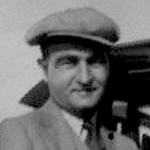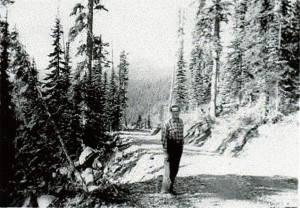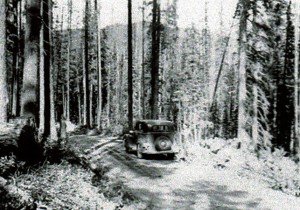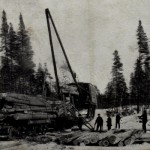north dakota
 My great aunt, Mina Albertine Schumacher, who went by Minnie as a child, but Min for most of her adult life, married John Clark Spare in Fargo, North Dakota on January 8, 1921. In the years preceding their marriage, John had enlisted in the North Dakota National Guard, Company B, at the age of 17 years. His company was assigned to the Rio Grande River Patrol on the Mexican border at Mercedes, Texas. Company B was patrolling one day, and John had an empty gun, because at that point, there was not enough ammunition to go around. Basically, the men who had loaded guns would have to cover the ones who did not, in the event of anything illegal happening along the border. I suppose that was the only thing that they could do, but I have to tell you that I would not feel very comfortable being one of those guys who did not have any ammunition at the border between Mexico and the United States. I realize that these days that border is probably more dangerous than it was then, but maybe not. Many of the outlaws from both countries ran to the other country to hide out from the law in their own country.
My great aunt, Mina Albertine Schumacher, who went by Minnie as a child, but Min for most of her adult life, married John Clark Spare in Fargo, North Dakota on January 8, 1921. In the years preceding their marriage, John had enlisted in the North Dakota National Guard, Company B, at the age of 17 years. His company was assigned to the Rio Grande River Patrol on the Mexican border at Mercedes, Texas. Company B was patrolling one day, and John had an empty gun, because at that point, there was not enough ammunition to go around. Basically, the men who had loaded guns would have to cover the ones who did not, in the event of anything illegal happening along the border. I suppose that was the only thing that they could do, but I have to tell you that I would not feel very comfortable being one of those guys who did not have any ammunition at the border between Mexico and the United States. I realize that these days that border is probably more dangerous than it was then, but maybe not. Many of the outlaws from both countries ran to the other country to hide out from the law in their own country.
On that day, John was patrolling near the bridge by the encampment, with his empty gun. Suddenly, a herd of horses was seen thundering toward them. Behind the herd was Pancho Villa and his gang of bandits. The gang was in a gun fight with the men from the Third Cavalry, from whom the gang had stolen the horses. The time had come for the border patrol to do their duty. It would be the job of the ones with the ammunition to engage the enemy and assist the Cavalry. The remainder of the men would need to dive under the bridge for cover. The men immediately prepared to take their necessary positions, and with one accord, all of the men of the border patrol dived under the bridge. Unbeknownst to the men, at least until that moment, they all had unloaded guns!! While that might seem like a funny thing to see all those men diving under that bridge because they did not have the ammunition to fight in the battle that was looming down on them, my guess is that it would also be a horrifying situation to the men hiding under the bridge hoping the battle would continue to go on down the road, and not circle back.
Following his time as part of the border patrol, John was called to the Guard full time, and assigned to guard the Fargo Armory, just as bombs were being placed at strategic points around the country to blow them up if it became necessary. I think it is a bit ironic that on his first assignment, John had no ammunition, and at his second assignment, when he was just going on 19 years of age, he was guarding a building that held larges stores of ammunition. I have to think that he must have thought to himself, “Where was all this ammunition when we were at the border?” John’s company would be taken into the Federal Army as the United States entered World War I. John would later re-enlist and fight in both world wars before he finally decided that he had served his time. I’m sure my Great Aunt Min was glad when he came home for good.
 My great grandfather, Carl Ludwig Theodor Schumacher, was born in the Province of Pommern in northern Germany, on May 23, 1859. He was one of the twelve children of Johann Freidrich Theodor Schumacher and Maria Maehling. He came to America after taking care of a wealthy landowners driving horses for several years beginning when he was 15. It was a job he loved very much, because he really loved horses. By the spring of 1884, he had saved enough money to pay for passage to America, with the plan of moving to Minnesota, where he had cousins.
My great grandfather, Carl Ludwig Theodor Schumacher, was born in the Province of Pommern in northern Germany, on May 23, 1859. He was one of the twelve children of Johann Freidrich Theodor Schumacher and Maria Maehling. He came to America after taking care of a wealthy landowners driving horses for several years beginning when he was 15. It was a job he loved very much, because he really loved horses. By the spring of 1884, he had saved enough money to pay for passage to America, with the plan of moving to Minnesota, where he had cousins.
Henriette Albertine Johanne Hensel was born in Schönwalde in the southern part of the Province of Pommern, in northern Germany on December 11, 1860. At the time she lived there all this land was part of the Prussian Empire. She was the second youngest of nine children of Carl Hensel and Henriette Tonn. Her father died before her younger brother was born in 1865. About that time, Henriette was sent to her older sister’s home to tend the 5 cows and 52 sheep she had. As time went on, she grew up and had a boyfriend…she was happy and content. Then everything changed for her. Her sister’s husband wanted to immigrate to America, and since Henriette was not married, her mother wanted her to go with them to help her with her two small daughters. She didn’t want to go, but she did go. The voyage was long, and the family spent much of it quite ill. Her sister’s husband never really recuperated fully, and he died just a few years later.
One Sunday a friend of Carl Schumacher’s asked him to sponsor at a baptism in his stead. At the baptism celebration, Carl met the mother of the baby, and her sister Henriette Hensel, who had both just recently come to America from Germany. For Carl, it was love at first sight, and he married the young lady just a year later in Belchester, Minnesota on November 12, 1886. Their marriage was blessed with seven children, Anna Louise (who became my grandmother), Albert August, Maria (who died at just three years of age), Mina Albertine, Frederick Carl, Bertha Emilie, and Elsa Ernestine.
About a year after Elsa was born, the family moved to a farm 12 miles from Lisbon, North Dakota. It was so different from Minnesota, and Albert, who was 15 at the time, fell in love with the wild country. In Minnesota he fished, but there was not much to hunt. Here there was lots to hunt, and guns quickly became Albert’s lifelong hobby. It was here, in 1910, that the family purchased their first surrey. It was a surrey with a fringed top. Anna married my grandfather, Allen Luther Spencer, then Albert married Christine Ida Froemke, and Mina was away at college in Fargo, finishing her high school. The neighbors started getting the new Model T car, and Albert had to have one, but Carl loved his horses, so he kept his surrey. Albert spent all of his spare time studying mechanics. Mina hated the farm, so Henriette wanted to make sure that her daughter received an education. In 1917, Henriette and Fred were both in bed with arthritis, but Henriette didn’t want Bertha to miss her senior year of high school, so she left her bed to care for Fred. After a few family meetings, they decided to leave Fred, who was feeling better now, to run the farm and the rest of the family moved to Fargo, North Dakota, where Carl and Henriette would spend the rest of their lives. Bertha graduated from Secretarial School and Elsa from high school. Mina married John Clark  Spare. Bertha married Arthur C Hallgren and Elsa married Frank Lawrence. Bertha and Elsa would not have children of their own, but would “adopt” their niece, Pauline Spare Holmberg’s children, Lisa, John, Kristen, and Julie. Between the four remaining children, Carl and Henriette would receive twenty one grandchildren, and a growing number of great grandchildren, great great grandchildren, and these days, great great great grandchildren. All this from a chance meeting when Carl stood in the stead of a sponsor who was unable to be there for a baptism…wow!!
Spare. Bertha married Arthur C Hallgren and Elsa married Frank Lawrence. Bertha and Elsa would not have children of their own, but would “adopt” their niece, Pauline Spare Holmberg’s children, Lisa, John, Kristen, and Julie. Between the four remaining children, Carl and Henriette would receive twenty one grandchildren, and a growing number of great grandchildren, great great grandchildren, and these days, great great great grandchildren. All this from a chance meeting when Carl stood in the stead of a sponsor who was unable to be there for a baptism…wow!!
 During the Depression years, many people were looking for work…any kind of work, because jobs were scarce, and money even more so. Many men were forced to leave their wives and young children to run the farms, so they could go out, sometimes several states away to look for work. It wasn’t just the husbands either. Many times, as in the case of my dad and my Uncle Bill, it was the sons who had to go find jobs too, because the family was simply not going to make ends meet if they didn’t. So it was that Dad and Uncle Bill set out for the Whitefish, Montana area to look for work. This trip would be quite an experience for the two brothers, who were in their teens at the time. It is my guess that my dad would have been around 15 years and Uncle Bill 17 years old at this time, but I could be off by a year or two. It doesn’t matter, because they were, nevertheless young.
During the Depression years, many people were looking for work…any kind of work, because jobs were scarce, and money even more so. Many men were forced to leave their wives and young children to run the farms, so they could go out, sometimes several states away to look for work. It wasn’t just the husbands either. Many times, as in the case of my dad and my Uncle Bill, it was the sons who had to go find jobs too, because the family was simply not going to make ends meet if they didn’t. So it was that Dad and Uncle Bill set out for the Whitefish, Montana area to look for work. This trip would be quite an experience for the two brothers, who were in their teens at the time. It is my guess that my dad would have been around 15 years and Uncle Bill 17 years old at this time, but I could be off by a year or two. It doesn’t matter, because they were, nevertheless young.
They got to Fosston, Minnesota that first night…taking it easy on Uncle Bill’s old Plymouth, and arriving about 8:30pm. They tried to find a room to rent for the night, but there were  none, and then someone said they could sleep at the jail, so they went to check it out. They were allowed to spend the night there, after showing identification, being searched, and leaving all their belongings except their clothes in the office. I’m sure they were really wondering if they would turn them loose the next morning, after such an ordeal, but while the beds were not the most comfortable, they had a place to sleep. Needless to say, they left Fosston the next morning, and headed to Osnabruck, North Dakota the next day, where they found work unloading bags of cement from a rail road box car. By the end of the day, they were exhausted and pretty certain that they couldn’t have lifted one more bag…no matter how much money was offered. They found a man and his son who had a threshing machine and several farms lined out to do threshing for, but not enough help, so they worked for him until continued rain ended the threshing for the year.
none, and then someone said they could sleep at the jail, so they went to check it out. They were allowed to spend the night there, after showing identification, being searched, and leaving all their belongings except their clothes in the office. I’m sure they were really wondering if they would turn them loose the next morning, after such an ordeal, but while the beds were not the most comfortable, they had a place to sleep. Needless to say, they left Fosston the next morning, and headed to Osnabruck, North Dakota the next day, where they found work unloading bags of cement from a rail road box car. By the end of the day, they were exhausted and pretty certain that they couldn’t have lifted one more bag…no matter how much money was offered. They found a man and his son who had a threshing machine and several farms lined out to do threshing for, but not enough help, so they worked for him until continued rain ended the threshing for the year.
Then, they decided to get out of North Dakota, and headed for Whitefish, Montana where they worked in the lumber business for a company called Kinshella Lumber, in the  beautiful mountains outside Whitefish. That area was one that they found to be a great place for adventure, and they spent a lot of time driving in the mountains when they were working. It was a time they would remember fondly, until October arrived, bringing with it some very cold weather. By this time, both boys were pretty much done with this trip, so they set out for home, with enough money to make another payment on the farm. They had an interesting adventure, to say the least, but I’m sure that grandma’s good cooking and their own beds were calling their names, and as Uncle Bill said, there was wood to be cut up for the stove.
beautiful mountains outside Whitefish. That area was one that they found to be a great place for adventure, and they spent a lot of time driving in the mountains when they were working. It was a time they would remember fondly, until October arrived, bringing with it some very cold weather. By this time, both boys were pretty much done with this trip, so they set out for home, with enough money to make another payment on the farm. They had an interesting adventure, to say the least, but I’m sure that grandma’s good cooking and their own beds were calling their names, and as Uncle Bill said, there was wood to be cut up for the stove.
 For a number of years some of my dad’s family worked in the lumber business like so many other people from the area near International Falls, Minnesota and northern Minnesota, North Dakota, and Wisconsin. Much of the lumber was then sent to the Sawmill and Paper mill in International Falls. The year was somewhere around 1912, and the equipment used was not like what is used in the lumber business of today. After the logs were dragged or “skidded” to the railroad, they were loaded on to the rail cars by a Yarder. A Yarder was a machine that traveled on railroads knows as “dummy lines” to the site where the logs were to be loaded. These machines appeared to be large and cumbersome, they were in reality, workhorses that could handle big jobs. Once the logs were hooked to the cables, the log could be skidded at a rate of 1000 feet per minute…making work around the machines, rather dangerous. Once the log was near the rail car, men and machines had to work together using cables and poles to load the logs onto the railroad car. Once again, this put the men in harm’s way. If a log slipped, it was very likely that it was going to hit someone, resulting in death or at the very least, serious injury.
For a number of years some of my dad’s family worked in the lumber business like so many other people from the area near International Falls, Minnesota and northern Minnesota, North Dakota, and Wisconsin. Much of the lumber was then sent to the Sawmill and Paper mill in International Falls. The year was somewhere around 1912, and the equipment used was not like what is used in the lumber business of today. After the logs were dragged or “skidded” to the railroad, they were loaded on to the rail cars by a Yarder. A Yarder was a machine that traveled on railroads knows as “dummy lines” to the site where the logs were to be loaded. These machines appeared to be large and cumbersome, they were in reality, workhorses that could handle big jobs. Once the logs were hooked to the cables, the log could be skidded at a rate of 1000 feet per minute…making work around the machines, rather dangerous. Once the log was near the rail car, men and machines had to work together using cables and poles to load the logs onto the railroad car. Once again, this put the men in harm’s way. If a log slipped, it was very likely that it was going to hit someone, resulting in death or at the very least, serious injury.
I’m not sure what my dad’s family member’s jobs were in that industry, but that would have been around the time they were working in that industry. Logging has always been a dangerous industry to be in anyway, due to the large trees falling. You can’t always predict exactly where they are going to fall, although they know more about that these days than they used to. Still, the thought of a log being pulled from one point to another at the rate of 1,000 feet a minute and having someone in the way of that…makes me cringe!!
When I was watching some of the old home movies from Bob’s family, I saw that some of them were in that same industry for a time. There was a stark difference in the way trees  were moved from place to place. The Harvester was able to go up into the area where the trees were being cut, and bring them down to the loader. The loader being on wheels, with a Diesel engine, was them able to lift the logs onto the trucks, without the need to “skid” them closer. No one needed to be around to work cables or anything else to get the logs on the truck. It made for a much safer situation for everyone concerned. Of course, every invention that we now had, came from a need seen by someone in the past, so I guess we have those loggers in the old days to thank for the safer conditions we now have. I’m just thankful that my ancestors lived through the time they spent in that industry.
were moved from place to place. The Harvester was able to go up into the area where the trees were being cut, and bring them down to the loader. The loader being on wheels, with a Diesel engine, was them able to lift the logs onto the trucks, without the need to “skid” them closer. No one needed to be around to work cables or anything else to get the logs on the truck. It made for a much safer situation for everyone concerned. Of course, every invention that we now had, came from a need seen by someone in the past, so I guess we have those loggers in the old days to thank for the safer conditions we now have. I’m just thankful that my ancestors lived through the time they spent in that industry.

